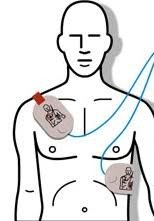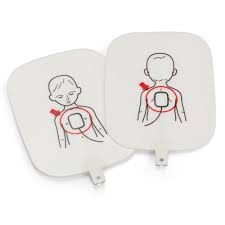BASIC LIFE SUPPORT
DEFIBRILLATION – AED (Automated External defibrillator)
The time to defibrillation is a key to better survival outcomes. For every minute defibrillation is delayed, there is approximately 10% reduction in the chance of survival in cardiac arrest due to Ventricular Fibrillation (VF). CPR alone will not save a person in VF. An AED should be attached as soon as possible when a casualty has been assessed as not breathing normally
And CPR is commenced. The use of an AED should not be restricted to trained personnel only. Allowing the use of AEDs by people even without prior training can be beneficial to the casualty and the modern AED’s provide good instruction and prompts for the rescuer. The AED assesses the hearts rhythm and will determine whether or not a shock is needed. An AED will analyse the heart every 2 minutes. keep providing CPR and following the prompts of the AED until paramedics arrive or the casualty starts breathing.
An AED (Automated External Defibrillator) is designed to restore a normal rhythm to a HEART when it has failed – there is a greater chance of survival if an AED is used within 10 minutes of the cardiac arrest as after 10 minutes, there is likely to be no electrical activity in the heart and the machine cannot help. Never be afraid to use the AED as it will not deliver a shock unless it is needed.
PAD PLACEMENT
- For Adults and children over 25kg (9years and above) correct pad placement ensures that a shock is delivered on an axis through the heart. The pads are placed on an exposed chest in an anterior-lateral position: one pad slightly below the collar bone on the persons right chest and one pad on the person’s left side below the arm pit. Other placement that are acceptable if needed include anterior-posterior position, where one pad is placed on the upper back between the shoulder blades and the other on the front of the chest (slightly to the left, if possible); and apex-posterior.
- Paediatric pads should be used for anyone under 25kg (up to 8 years of age) and placed as shown by the picture on the pads which is either anterior-lateral or anterior-posterior. If pads placed in the anterior-lateral position are closer than 8cm apart, then an antero-posterior position should be used to avoid arcing.
- If a casualty has an implant such as a pacemaker, then the pads should be placed at least 8cm away from the implant to avoid damage. If this becomes difficult because the implant us near to normal pad positioning, an anterior-posterior position may need to be adopted where one pad is placed on the upper back between the shoulder blades and the other on the front of the chest (slightly to the left, if possible); and apex-posterior.


Adult pad placement Infant/child pad placement
